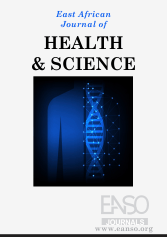The Characteristics and Outcomes of Women Admitted with Preeclampsia at JOOTRH: A Review of June 2021 to December 2021
Abstract
Preeclampsia is a hypertensive disorder in pregnancy occurring after 20 weeks of gestation and characterised by elevated blood pressure, proteinuria and oedema. It is one of the feared complications in pregnancy and contributes to maternal and perinatal morbidity and mortality. However, in Kisumu County and western Kenya in general there is no recent publication on risk factors and prevalence of preeclampsia and its contribution to maternal and perinatal morbidity and mortality The objective of this study was to determine the characteristics and outcomes of women admitted with preeclampsia at Jaramogi Oginga Odinga Teaching and Referral Hospital in Kisumu County in Western Kenya. The purposive sampling technique was used and women diagnosed with preeclampsia within the study period were included while those without preeclampsia were excluded. Data collection was by retrospective review of medical records where 80 files were reviewed. The records were obtained from files in the Hospital’s records department. The collected data was analysed using descriptive statistics involving the calculation of means, frequencies and standard deviation. The analyzed data was then presented in pie charts, tables and bar graphs which aided in interpretation. Ethical approval for the study was obtained from the Jaramogi Oginga Odinga Teaching and Referral Hospital Ethics Review Committee (JOOTHERC). The finding revealed that the majority of the women 31.25% were below 24 years old. Secondly, primiparity and parity of 1 accounted for 55% of the subjects while 9% had a parity of more than 4 and 36% had a parity of 2 to 3. Third, 26% of the women had a history of chronic hypertension and 11% of the women had a history of diabetic mellitus. Fourth, 80% of the women had a singleton pregnancy. Fifth, 77% of the women had mild preeclampsia at the time of diagnosis. Sixth, 51% of women had no complications while for those who complicated, 24% developed severe preeclampsia, 16%progressed to eclampsia, 5 % went into acute renal failure, 3% had pulmonary oedema and 1% succumbed from preeclampsia complications. Seventh, perinatal outcomes were 16% had IUFD, 15% were delivered preterm and those with respiratory distress were at 13%. In conclusion, common risk factors of preeclampsia included age less than 24 years and primiparity. The majority of the women had mild preeclampsia at the time of diagnosis. The majority of the women had no complications while the common complications recorded were eclampsia and severe preeclampsia with a few developing acute renal failure, pulmonary edema and death. Intrauterine fetal death, preterm delivery and respiratory distress were the common neonatal complications. The study recommends that attention be focused on primigravidas in prenatal care and antenatally focusing on preeclampsia counselling and Blood pressure monitoring
Downloads
References
Abalos, E., Cuesta, C., Grosso, A. L., Chou, D., & Say, L. (2013). Global and regional estimates of preeclampsia and eclampsia: a systematic review. European Journal of Obstetrics & Gynecology and Reproductive Biology, 170(1), 1-7.
Amorim, M. M. R., Santos, L. C., Porto, A. M. F., & Martins, L. K. D. (2001) Risk factors for maternal death in patients with severe preeclampsia and eclampsia. Institute MaternoInfatil de Pernambuco.
Backes, C. H., Markham, K., Moorehead, P., Cordero, L., Nankervis, C. A., & Giannone, P. J. (2011). Maternal preeclampsia and neonatal outcomes. Journal of pregnancy, 2011.
Benfateh, M., Cissoko, S., Boufettal, H., Feige, J. J., Samouh, N., Aboussaouira, T., & Alfaidy, N. (2018). Risk factors and poor prognostic factors of preeclampsia in Ibn Rochd University Hospital of Casablanca: about 401 preeclamptic cases. Pan African Medical Journal, 31(1).
Bdolah, Y., Chun, L., Augustine, R., Venkatesha, S., Walter, M., Benjamin, S., Kee, H. L., Tali, B., Franklin, H. E & Karumanchi, A. (2008). Twin pregnancy and the risk of preeclampsia: bigger placenta or relative ischemia? American Journal of Obstetrics and Gynecology.
English, F. A., Kenny, L. C., & McCarthy, F. P. (2015). Risk factors and effective management of preeclampsia. Integrated blood pressure control, 8, 7.
Garovic, V. D., & August, P. (2013). Preeclampsia and the future risk of hypertension: The pregnant evidence. Current hypertension reports, 15(2), 114-121. https://doi.org/10.1007/s11906-013-0329-4.
Jensen, D.M., Damn, P., Moelsted- Pedersen, L., Ovesen,P., Westergaard, J.G.,Moeller, M.,& Beck-Nielsen, H.(2004).Outcomes in type 1 diabetic pregnancies: a nationwide, population based study.Diabetes care, 27(12), 2819-2823. https://doi.org/10.2337/diacare.27.12.2819
Luealon, P., & Phupong, V. (2010). Risk factors of preeclampsia in Thai women. J Med Association of Thailand, 93(6), 661-6.
Ministry of Health (2017) Saving Mothers’ Lives: First Confidential report into Maternal deaths in Kenya. Nairobi.
Ndwiga, C., Odwe, G., Pooja, S., Ogutu, O., Osoti, A., & E. Warren, C. (2020). Clinical presentation and outcomes of pre-eclampsia and eclampsia at a national hospital, Kenya: A retrospective cohort study. Plos one, 15(6), e0233323.
Opitasari, C., & Andayasari, L. (2014). Parity, education level and risk for (pre-) eclampsia in selected hospitals in Jakarta. Health Science Journal of Indonesia, 5(1), 35-39.
Paruk, F., & Moodley, J.(2000). Maternal and neonatal outcome in early and late onset preeclampsia. seminars in neonatology: SN,5(3),197-207
Rana, S., Lemoine, E., Granger,P. J. & Karumanchi, A. ( 2019). Preeclampsia: pathophysiology, challenges and perspectives. Circulation Research. 2019; 124:1094-1112.
Tsigas, E. Z. (2021). The Preeclampsia Foundation: the voice and views of the patient and her family. American Journal of Obstetrics and Gynecology.
Wandabwa, J., Doyle, P., Kiondo, K., Campbell, O., Maconichie, N., & Welishe, G. (2010). Risk factors for severe pre-eclampsia and eclampsia in Mulago Hospital, Kampala, Uganda. East African Medical Journal, 87(10).
Yang, Y., Le Ray, I., Zhu, J., Zhang, J., Hua, J., & Reilly, M. (2021). Preeclampsia Prevalence, Risk Factors, and Pregnancy Outcomes in Sweden and China. JAMA Network open, 4(5), e218401-e218401.
Copyright (c) 2024 Gunyanyi Valentine, MBChB, Keter Lorraine Jerop, MBChB, Mohamed Noor Edon, MBChB, Nasra Daud Sheikh, MBChB, Onsare Gilbert Kinara, MBChB, Ednah Kerubo Boera, MBChB, Onesmus Mutuku, MBChB

This work is licensed under a Creative Commons Attribution 4.0 International License.




























